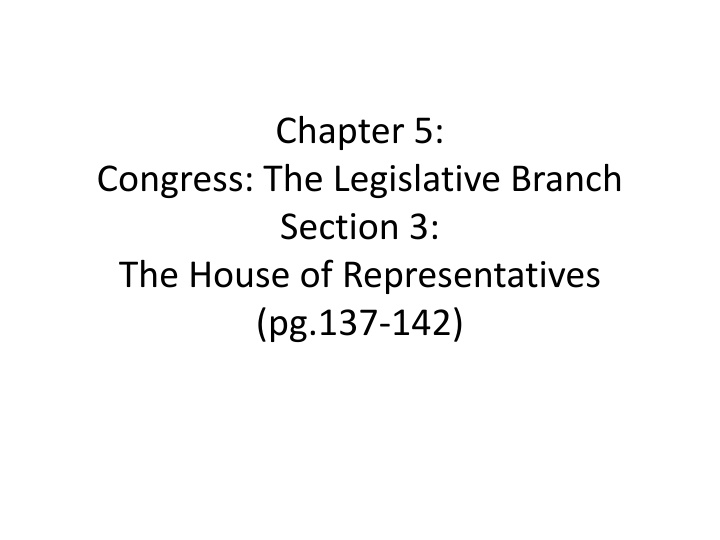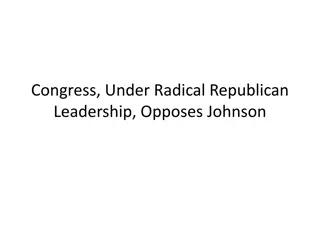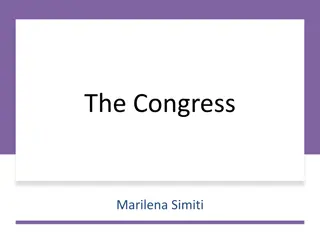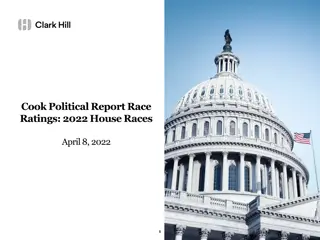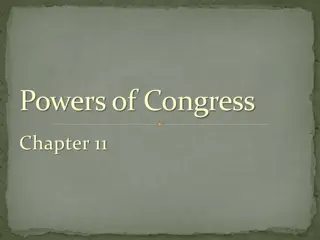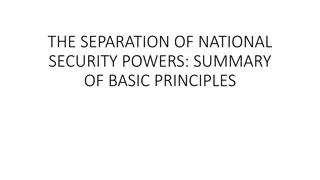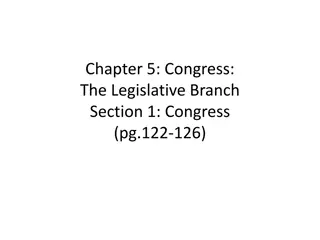House of Representatives in Congress
The House of Representatives, as a key part of the US Federal Government, serves as a direct link to the people. Explore its membership, terms, benefits, qualifications, reapportionment, and redistricting processes.
Download Presentation

Please find below an Image/Link to download the presentation.
The content on the website is provided AS IS for your information and personal use only. It may not be sold, licensed, or shared on other websites without obtaining consent from the author.If you encounter any issues during the download, it is possible that the publisher has removed the file from their server.
You are allowed to download the files provided on this website for personal or commercial use, subject to the condition that they are used lawfully. All files are the property of their respective owners.
The content on the website is provided AS IS for your information and personal use only. It may not be sold, licensed, or shared on other websites without obtaining consent from the author.
E N D
Presentation Transcript
Chapter 5: Congress: The Legislative Branch Section 3: The House of Representatives (pg.137-142)
https://c1.staticflickr.com/9/8183/8395638677_18aa761159.jpg Membership in the House The Framers intended the House of Reps. To be the chamber most closely in touch with the people. The House was the only part of the Federal Gov. directly elected by the people. The House was to be kept in check by the Senate which was to be elected by state legislatures. http://www.greenmanspage.com/wp-content/uploads/2015/07/U.S.-House-of-Representative.jpg
House of Representatives: Terms, Salary, Benefits, & Privileges Term- 2 years Salary for a member- $174,000 Salary for Majority & Minority leaders $193,400 Salary for Speaker of the House $193,400 Tax deduction for two residences Travel allowances Staff Health and retirement Franking privileges Free printing Use of gym, restaurants, and other amenities in the Capital Legal immunity for statement made while Congress is in session http://image.slidesharecdn.com/congress-chapter-11-100310232258-phpapp02/95/congress-chapter-11-52-728.jpg?cb=1268264472
Formal & Informal Qualifications Formal 25 years old A U.S. Citizen for 7 years A resident of the state he or she represents Congress can expel a sitting member for any reason w/ two-thirds vote (5 times) Informal Appeal to voters Military background Being a lawyer or politician Being famous (actors, athletes) Ability to raise a lot of money, in 2010 candidates for the House spent $1.5 million https://upload.wikimedia.org/wikipedia/commons/c/c0/Speaker_Nancy_Pelosi.jpg The First Woman Speaker Nancy Pelosi 2007-2011
Reapportionment & Redistricting 435 member with over 320 million people in the U.S., that is an average of around 700,000 people per representative Every 10 years, the House must undergo reapportionment, in which seats are redistributed among the states based on the census In 1929, Congress fixed the number of seats in the House to 435, which means that states that add population get more representatives and the states that lose population lose seats. https://compliancecampaign.files.wordpress.com/2012/01/redistrictinggop.jpg
Redistricting The Congress allows state governments to draw the district boundaries within their states. Not surprisingly, the party in power tends to draw the boundaries to its political advantage: this is called gerrymandering. Over the last 50 years the Supreme Court has placed restrictions on this practice. The Court has tried to make one person s vote be worth as much as another s. T/f the Court has ruled that districts within a state should be roughly equal. Even so gerrymandering is still alive today b/c the control of the House is at stake. http://upload.wikimedia.org/wikipedia/commons/thumb/2/24/TravisCountyDistricts.png/800px-TravisCountyDistricts.png
Leadership in the House The most powerful member is the Speaker of the House. The Speaker is elected from the majority party. The Speaker s powers come from House rules and tradition. The Speaker presides over debates, recognizes speakers, rules on points of order, assigns bills to particular committees, and the speaker assigns members to certain committees. The Speaker of the House is also 2nd in line of succession to the presidency. http://1f0hrf3k9u4d4eiecjguy0r1bn5.wpengine.netdna-cdn.com/wp-content/uploads/2014/04/ap-boehner.jpg Speaker John Boehner 2011-2015
Other Leadership Posts Each party also elects a floor leader The floor leader of the majority party is called the majority leader & is the assistant to the Speaker The floor leader of the minority party is called the minority leader & acts as a spokesperson for the minority Both parties also elect whips. Their job is to encourage fellow party members to vote with their party Elections take place at the beginning of the congressional term at the party caucus, which is a meeting of all the members from a particular party. http://a57.foxnews.com/media2.foxnews.com/thumbnails/i/062214/780/438/062214_FNS_McCarthy_640.jpg Majority Leader Kevin McCarthy
House Rules The House can issue a reprimand or a stronger statement of House disapproval of a member s actions is called a censure. As noted before the House can expel a member for almost any reason. The House also has a Rules Committee, which acts as the traffic cop for the House, setting the rules for when, how, and under what conditions debate on a bill will take place. The Rules Committee controls how long debate can last on a bill, t/f effecting the speed a bill can be passed. https://upload.wikimedia.org/wikipedia/commons/2/29/Pete_Sessions.jpg Chair of Rules Committee Pete Session R-TX
The Role of Committees No member could possibly have the knowledge needed for all the topic that come before the House t/f there are Committees. Standing Committees are permanent committees that address issues like agriculture, the budget, & armed services. An example is the House Committee on Ways and Means, which deals w/ taxes and other revenue raising measures. Standing Committees typically have at least four subcommittees. http://image.slidesharecdn.com/congress-090326202847-phpapp01/95/congress-54-728.jpg?cb=1238099500
Other Committees The House sometimes creates select committees to carry out specific tasks not already covered by existing committees such as investigations. They usually only serve for a limited time. The House and Senate sometimes form joint committees and they address issues that affect both chambers, ex. tax policy. Each committee has a chair and the chair comes from the majority party. In the past the job went to the most senior person on the committee but now the chair can only hold the post for six years. Members of the House ask to be on committees that effect their district and each committee has their own staff. http://maprx.info/wp-content/uploads/2011/11/JSCDR-mockup.jpg
